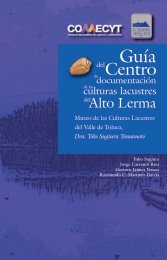You also want an ePaper? Increase the reach of your titles
YUMPU automatically turns print PDFs into web optimized ePapers that Google loves.
JOCELYN OLCOTT, SURFING THE NEW WAVE: INTERNATIONAL WOMEN’S YEAR<br />
AND THE GEOPOLITICS OF 1970S MEXICAN FEMINISM<br />
parts. While US feminists struggled for the<br />
passage of the Equal Rights Amendment,<br />
Echeverría effectively had decreed one by<br />
fiat. While US and European feminists debated<br />
the merits of demanding wages for housework,<br />
Mexican feminists generally paid<br />
someone else to perform this labor, creating<br />
what novelist Rosario Castellanos described<br />
as a cushion –un colchoncito– that insulated<br />
Mexican women from the structural contradictions<br />
that animated feminist movements<br />
elsewhere (Lau Jaiven, 2000: 15; Acevedo,<br />
2000; Collectif de femmes d’Amérique latine<br />
et de la Caraïbe, 1977: 83-99; Larguía,<br />
1972). As Castellanos wrote, “When the <strong>las</strong>t<br />
servant (la última criada), the cushion on<br />
which our conformity now rests, has disappeared,<br />
there will appear the first furious<br />
rebel” (Excélsior, March 5, 1970; quoted in<br />
Ludec, 1999: 283). Finally, the government’s<br />
eagerness to co-opt feminism confronted<br />
activists with a textbook quandary of<br />
co-optative regimes: whether to accept government<br />
support or to reject it and retain<br />
their autonomy.<br />
Infrastructures of Activism: Programming<br />
and Counter-Programming<br />
The IWY conference and attendant programming<br />
galvanized feminist activists on<br />
both sides of this divide to dedicate time,<br />
energy and resources to take advantage of<br />
this national and international attention to<br />
feminist concerns. The level of state support<br />
raised the stakes of opting out of the official<br />
program. As Esperanza Brito de Martí, the<br />
leader of the Movimiento Nacional de Mujeres<br />
later recalled:<br />
At the end of 1974, Lic. Pedro Ojeda Paullada<br />
[Procurador General de la República], in his<br />
role as General Coordinator of International<br />
Women’s Year, convened us, as with all the<br />
groups, to chat, get to know our projects, and,<br />
if possible, to incorporate them into the Official<br />
Program. We were ready to carry out, under<br />
the leadership of Luz Elena Picos, a cycle of<br />
conferences that would take place in 12 of the<br />
16 <strong>del</strong>egations of the Distrito Federal. Only in<br />
12 because four <strong>del</strong>egates did not accept our<br />
presence. The dates had already been agreed<br />
upon with the 12 <strong>del</strong>egates; that is to say, we<br />
were ready to start. In a very gentle manner,<br />
we were informed that we would only be able<br />
to carry out the project if we were incorporated<br />
into the Official Program, and thus our<br />
group’s activity started, in January 1975, as<br />
the Official Program of the International Women’s<br />
Year (Brito de Martí, 1996: 17).<br />
Once the group signed on, the funding<br />
came pouring in, amounting to support for<br />
144 conferences during the course of the<br />
year. The group’s collaboration came with a<br />
price tag, however. Brito recalled:<br />
During these first years of our group’s existence,<br />
we were rejected and discriminated<br />
against by members of other feminist groups.<br />
There was an enormous distrust among the<br />
groups, and this translated into the total dissolution<br />
of the movement. They accused us<br />
of being members of the PRI, which we never<br />
were, of being petty bourgeois because<br />
we didn’t wear jeans, and of being reformist<br />
because we wanted to change the laws (Brito<br />
de Martí, 1996: 17).<br />
For her part, Marta Lamas remembers<br />
1975 as an exhausting year as dissident feminist<br />
activists struggled to keep pace with<br />
official programming (Lamas, 1996: 10). As<br />
the historian Ana Lau Jaiven recounts, seeing<br />
the UN and Mexican state projects as a<br />
“lukewarm and opportunistic appropriation<br />
of feminist proposals”, a committed group<br />
of feminists formed the Women’s Front<br />
against International Women’s Year (Lau<br />
Jaiven, 2000: 20-<strong>21</strong>; Acevedo, 2000: 63).<br />
Taking advantage of the spotlight cast by<br />
the official propaganda, the group traveled<br />
all over the country convening conferences,<br />
presenting street theater, organizing movie<br />
clubs, planning solidarity actions with female<br />
wage workers, meeting with feminists<br />
from various countries, and passing out flyers<br />
everywhere they could. Citing the official<br />
IWY themes of equality, development,<br />
and peace, the flyers proclaimed, “We do<br />
206



![bicentenario_1[V2]](https://img.yumpu.com/68677971/1/167x260/bicentenario-1v2.jpg?quality=85)
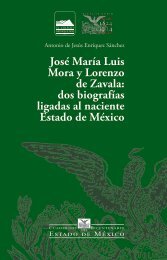
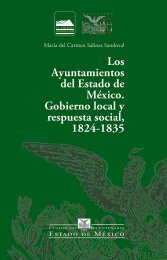

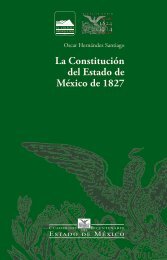
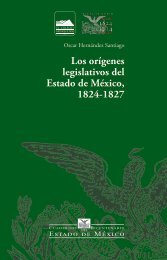
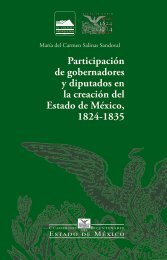
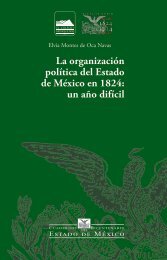
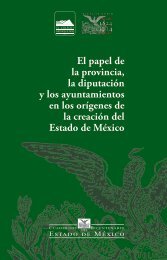


![El_primer_federalismoEM[final]_compressed (2)](https://img.yumpu.com/68483279/1/178x260/el-primer-federalismoemfinal-compressed-2.jpg?quality=85)

